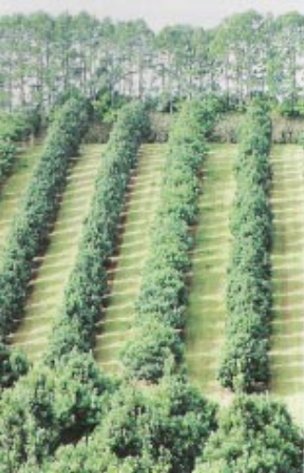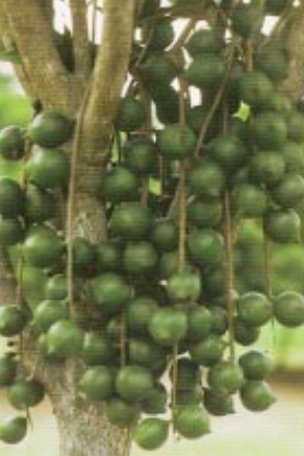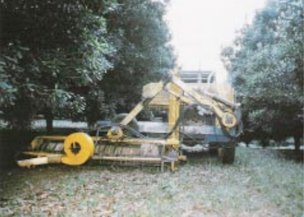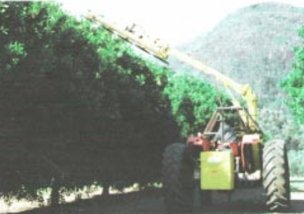Article from the
West Australian Nut and Tree Crop Association
by Russ Stephenson

Macadamia: Domestication and Commercialisation
The macadamia is
considered one of the world's finest gourmet nuts because of its
unique, delicate flavour, its fine crunchy texture, and rich creamy
colour. Nuts from wild macadamia trees provided a source of food for
the aboriginals in the Australian subcontinent, but Australian farmers
were slow to appreciate the commercial potential of this fine nut.
OriginThe
macadamia nut is the only commercial food crop indigenous to Australia,
originating along the fringes of rainforests in coastal southeast
Queensland and northeast New South Wales (25 to 32°S latitude). The
tree has several features suggesting adaptation to harsh environments,
including sclerophyllous leaves and dense clusters of fine, proteoid
roots that develop to enhance nutrient uptake from poor soils,
particularly those low in phosphorus. Of the four southern species of
macadamia, only two are edible, the smooth-shelled Macadamia integrifolia and the rough-shelled M. tetraphylla.
Only the former has been developed commercially. The latter, grown on
moderate scale in California and New Zealand, produces a raw kernel of
excellent eating quality but contains a higher percentage of sugar that
may caramelise on roasting, thus detracting from its appearance and
reducing its effective shelf life. The wild M. ternifolia produces a
small, unpalatable, bitter kernel. M. jansenii was first discovered in
1982 and there are less than 100 known individuals surviving in the
wild. It has small inedible fruit.
The evergreen macadamia tree is medium to large, attaining a height of up to 20 m and a spread of up to 15 m. In M. integrifolia,
the leaves are arranged in whorls of three and often have spiny,
dentate margins, and short (5-15 mm) petioles. Multiple branches (or
inflorescences) may be produced from each node. The pendulous racemes,
up to 15 cm long and bearing approximately 200 creamy, white flowers,
are borne on hardened wood. Less than 5% of flowers set fruit and the
nuts take 6 months to mature, after which they abscise naturally. The
fruit is a globose follicle in which two ovules develop. As the husk
dries, it splits along a single suture to release the nut, consisting
of a hard, thick, stony, light-tan shell (the seed coat) that encloses
the kernel.
The leaves of M. tetraphylla are
sessile and are arranged in whorls of four. The margins are more
serrated, with up to 40 spines on each each side and, whereas new leaf
growth of M. integrifolia is pale green in colour, young M. tetraphylla leaves are an attractive pink to red colour. Racemes are longer (up to 30 cm) and bear up 500 reddish-pink flowers.
History
A
German explorer, Ludwig Leichhardt, was the first person to collect
macadamia. Some time later, in 1857, Ferdinand von Mueller, the
Director of the Royal Botanical Gardens in Melbourne, and Walter Hill,
the superintendent of the Brisbane Botanical Gardens, discovered a
macadamia tree on the banks of the Pine River, 30 km north of Brisbane.
Von Mueller described the specimen and named it after his good friend,
Dr John Macadam.
One of the earliest macadamia orchards in
Australia was established at Rous Mill, near Lismore, in the early
1880s and it is still producing nuts today. Other small blocks were
planted throughout New South Wales and Southeast Queensland, but the
total area prior to 1960 was less than 100 ha with annual production of
less than 50 tonnes (t) of nut-in-shell.
Although the macadamia
is native to Australia, large-scale commercial development first
occurred in Hawaii after trees were imported by William Purvis, also in
the early 1880s. It was not, however, until the early 1920s that the
first developmental macadamia orchards were established in Hawaii. A
major breakthrough to commercialisation was the development of
efficient cracking machines. The first truly commercial orchards were
established by Castle and Cooke at Keauhou on the island of Hawaii in
1948.

Small nuts of Macadamia ternifolia compared with the
larger commercial nuts of M. integrifolia
The
development of the macadamia industry was supported by research at the
Hawaii Agricultural Experiment Station at the University of Hawaii. An
early achievement was the discovery of the importance of starch
accumulation above girdled branches for successful grafting, resulting
in true-to-type trees that commenced bearing earlier, and produced much
higher yields than seedling trees. J H Beaumont and R H Moltzau
initiated a cultivar selection program in 1936 and William Storey
released the first 5 cultivars from 20,00 bearing trees in 1948, two of
which ('Keauhou'=HAES 246 and 'Kakea'=HAES 501) were the basis for
early commercial orchards in Hawaii, and later in Australia and other
parts of the world. Cultivar trials using grafted trees were
established on all the major islands of Hawaii.
Other important
cultivars released were 'Ilaika' (HAES 333) , 'Kau' (HAES 344), 'Keaau'
(HAES 660), Mauka' (HAES 741) and 'Makai (HAES 800). In 1960, Storey
visited Australia and collected additional new germplasm for evaluation
in Hawaii. Richard Hamilton enthusiastically promoted the development
of the macadamia industry and continued the variety selection work, as
did his student, Phil Ito.
The importance of maintaining high
quality standards in the developing Hawaiian industry was acknowledged
by J C Ripperton, R H Maltzau and D W Edwards, who developed effective
quality assessment procedures for factories. Their simple and
convenient flotation test for maturity was widely adopted. Kernels that
float on tap water have at least 72% oil and are considered mature.
They
also developed the concept of kernel recovery (the percentage of kernel
within the nut), an important quality feature, particularly in those
early days when many orchards were based on variable seedling trees
that produced nuts with thick shells. More recently, Cathy Cavaletto's
postharvest research at the University of Hawaii has underpinned the
high quality of macadamias in the marketplace.
From the early
1950s to the 1970s, research was carried out by B J Cooil, G T
Shigeura, R M Warner, R L Fox and coworkers to overcome nutritional
constraints to productivity in Hawaiian macadamia orchards and to
develop leaf analysis standards for optimum production and quality.

Flowers of Macadamia integrifolia (left) and M. tetraphylla (right)
Yields
were enhanced by applying phosphorus fertilizer to lava and
phosphorus-fixing soils. Excess phosphorus (leaf P greater than 0.1 %),
however, resulted in the formation of insoluble iron phosphates in the
soil, and consequently, leaf chlorosis. This work provided the basis
for the development of macadamia orchards not only in Hawaii, but also
in Australia and other parts of the world.
Macadamias in Australia
It
was not until the early 1960s, when the Hawaiian macadamia industry was
already well established, that efforts were made to develop the
indigenous macadamia as a commercial crop in Australia.

An Australian macadamia orchard in northern New
South Wales bounded by tall windbreak trees
Colonial
Sugar Refiners (CSR) imported superior selections and technical
expertise from Hawaii. Other large commercial operations were soon
established, with income-tax incentives for investment in the industry.
Although CSR imported the best varieties from Hawaii, it became obvious
their performance was often disappointing and they were not necessarily
well adapted to Australian conditions. It was widely acknowledged that
local research was needed to select varieties better adapted to
Australian conditions, and to similarly modify the Hawaiian cultural
technology.
As in Hawaii, the Australian macadamia industry was
fortunate in having a large number of enthusiasts and innovators who
contributed to the improvement of the industry. The most prominent of
these was Norm Greber, widely regarded as the founding father of the
Australian macadamia industry. He was the first Australian to
successfully graft macadamia and was engaged by CSR to help develop
their macadamia nursery. Norm also propagated many trees in his back
yard and selected superior cultivars, including 'Own Choice, 'Own
Venture', 'Renown', 'Ebony' and 'Greber Hybrid'. He received life
membership of both the Australian and the Californian Macadamia
Societies for his contribution to the development of the macadamia
industry and became patron of the Australian Macadamia Society.

Bunches of macadamia nuts
Stan
Henry, the CSR nursery manager, subsequently developed a novel punch
budding technique using a modified, spent 0.303 brass bullet shell to
remove an oval patch of bark from the rootstock that was replaced with
a patch containing a single bud from the commercial scion.
This
rapid, effective technique gave CSR a considerable advantage over
nurseries employing conventional grafting techniques. The success of
punch budding was largely due to careful selection of budwood with bark
that lifted readily. The CSR nursery supplied all the trees for the
first large-scale commercial orchards at Baffle Creek, north of
Bundaberg, Maleny, Peachester, Mt Bauple, and Rockhampton, totalling
over 1,000 ha. In the 1970s, the first commercial processing plant was
established by CSR. Soon after, other factories were established by
Suncoast Gold Macadamias and by the Macadamia Processing Co and
Macadamia Plantations of Australia. Today, there are about 10 factories
operating in Australia.
The Australian Macadamia Society
The
macadamia industry in Australia is particularly fortunate in having
forged a strong and effective organisation, the Australian Macadamia
Society Limited (AMS). It was established in 1974 by a small group of
enthusiasts eager to share the benefits of their experience and their
innovative ideas. Ever since, it has responded to needs and
opportunities across the whole industry. It fosters the dissemination
of information through its bimonthly News Bulletin, website, MacGroup
meetings, field days, and annual conferences. These very effective and
powerful extension functions complement services provided by State
Departments of Agriculture.
Perhaps the most significant
initiative of AMS was the active encouragement of research into
production, processing and promotion of the crop. Initially, research
was funded from a voluntary levy. In 1993, a production levy,
attracting a subsidy from the Commonwealth Government, was introduced.
This intensified research activity and flow-on benefits to the
industry. The industry levy is currently 25.21 cents/kg total kernel of
which 17.4 c/kg is for product promotion and marketing, amounting to an
annual budget of about A$2 million. A further A$2 million is invested
in research each year, half of which comes from the Commonwealth
Government as a matching dollar for dollar subsidy. Part of the levy is
also used for regular chemical residue testing to maintain Australia's
reputation for producing high quality, quality-assured kernel.

Premium macadamia kernels
Research in Australia
One
of the great challenges was the selection of genetic material better
adapted to Australian environments. In Hawaii, over 100,000 trees were
screened to select the commercial cultivars that are widely used today,
whereas in Australia, fewer than 20,000 seedlings have been screened.
Two of Henry Bell's Hidden Valley cultivars (A4 and A16) are registered
under Plant Breeders Rights legislation and widely grown commercially,
together with subsequent releases.
The AMS currently funds a
major plant breeding program to develop superior cultivars for
Australia. To assist in the search for, and development of, better
adapted cultivars, the AMS has also provided funds to conserve a wide
range of germplasm from native rainforests before they are lost forever
by land clearing.

A macadamia fingerwheel harvester significantly reduces
harvesting cost
Early
macadamia yields in Australia were generally quite low compared with
those reported from Hawaii, although some trees approached the Hawaiian
yield standard of 45 kg nut-in-shell. Yields of 30 kg are more common
and productivity continues to improve steadily with better technology.
It seems that one of the factors contributing to lower yields in
Australia, and many other countries, is harsher environments with
larger diurnal and seasonal variations in temperature than in the mild,
equable climate of Hawaii.
Understanding the influence of
environment on macadamia growth and production was an essential
objective of early macadamia research (and management). The mature
macadamia is capable of withstanding mild frosts to as low as -6 °C for
short periods, but extended periods or lower temperatures may severely
damage or kill mature trees.
Even where trees survive, frosts
may burn off inflorescences and thus seriously reduce cropping. Optimum
temperature for tree growth and photosynthesis is about 26 °C.
Temperature is a major factor influencing vegetative flushing, which,
in turn, influences floral initiation, nut growth, yield and quality.
Most
genera of Proteaceae grow only in climates where there is a long dry
season. Drought, however, limits yield and results in small nuts with
undeveloped kernels. Research at the Maroochy Research Station in a
through-draining lysimeter showed that even mild stress during nut
development, particularly the oil accumulation stage, adversely
affected both yield and quality.
Fortunately, the macadamia has
few serious ease problems and when these occur they tend to be
localised. An example is a husk spot fungus (Pseudocercospora), which induces nuts drop early in the harvest season before they fully mature.
In
Australia, its place of origin, the macadamia is attacked by more than
150 pest species, although parasites and predators usually provide
considerable control. Insects that commonly reduce yields include macadamia flower caterpillar (Homoeosoma vagella), fruit spotting bug (Amblypelta nitida), banana spotting bug (AmbIypeIta lutescens), macadamia nutborer (Crytophlebia ombrodelta) and macadamia felted coccid (Eriococcus ironsidei).
Any of these has the capacity, during severe infestations, to destroy
the crop. An integrated pest management system for insect pest control
has been adopted.
Pest population levels are monitored in the
orchard by pest scouts and chemical sprays are only applied when
threshold pest population levels are reached. This approach maximizes
the contribution of natural enemies in suppressing pest populations
below economic threshold levels. PM has contributed to the
profitability of macadamia growing.
Early nutrition work in
Australia refined the Hawaiian standards to suit Australian conditions.
It was found that small, frequent applications of nitrogen, for
example, effectively restricted tree growth but actually increased
yield and quality of nuts. Many of the soils on which macadamias are
grown in Australia are low in boron, and foliar boron sprays improve
both yield and quality (kernel recovery). As in Hawaii, phosphorus
deficiency limited yields on phosphorus-fixing ferrosol soils.

Mechanical pruning of a high density macadamia orchard
Because
of the long break-even period (10-12 years) for a net return on money
invested in macadamias, the Australian industry moved towards
high-density plantings to increase early cash flow. Mechanical pruning
is used to maintain hedgerows and allow normal orchard operations such
as spraying and harvesting.
The AMS responded to indifferent
quality by adopting stringent quality standards and financial
incentives to encourage growers to sort poor quality nuts from their
consignments. This significant step has enhanced Australia's reputation
on world markets as a supplier of consistently high quality kernel. The
industry places a lot of importance on maintaining this reputation. It
has developed a 'Code of Sound Orchard Practices' to help achieve this.
Commercialisation
World
consumption of macadamias accounts for only about 2-3% of all tree
nuts. For example, only 23,000 t of macadamia kernels is consumed
compared with 650,000 t of almonds, 370,000 t of walnuts, 330,000 t of
hazelnuts, 250,000 t of cashews, 200,000 t of pistachios and 110,000 t
of pecans. There is, therefore, considerable scope for expanding world
markets.

Figure 1. World macadamia consumption (t) (2003).
Source: Australian Macadamia Society (www.macadamias.org);
US Embassy, Canberra; Hargreaves (2004).
The
USA is still the largest market for macadamias, which are particularly
popular in cookies (Fig. 1). Bakery products account for about 40% of
world production. Another 35% is used as snacks, 22% is coated in
chocolate, mainly for the Japanese market, and about 3% used in ice
cream. The Australian industry is actively investing in promotion of
macadamias to diversify its markets, particularly into Japan, Europe
and Asia.
Although Australia's production of macadamias was only
about 25% of that of Hawaii's in 1987, Table 1 shows that it is now
greater, particularly the production of kernel. Australia has a
considerable advantage due to a higher kernel recovery. Nearly half the
world's macadamia exports come from Australia. Massive expansion of
plantings continues, particularly in Australia and South Africa. There
are now over 5 million trees planted on 15,000 ha in Australia, with
production valued at around A$150 M, at the farm gate.
| Table
1. World macadamia production and exports. Sources: Australian
Macadamia Society (www.macadamias.org); Australian Bureau of
Statistics; US Embassy, Canberra; Hawaii Agricultural Statistics
Service, July 12 2004; World round-up reports (Proceedings of the
Second International Macadamia Symposium, Tweed Heads, Australia, 2003). | | Country or region | Area
(ha) | Trees
(000) | 2003 production (t) | % Kernel recovery exports (t) | Kernel recovery exports (t) | | NIS+ | Kernel | | Australia | 15,000 | 5,000 | 30,000 | 9,100 | 32 | 7,460§ | | Central America | 8,700 | - | 17,000 | 3,100 | 18 | 3,100 | | USA (Hawaii) | 7,284 | 1,350 | 27,240 | 4,500 | 25 | 200 | | South Africa | 7,000 | 3,073 | 12,500 | 3,400 | 28 | 2,975 | | Kenya | 6,500 | 1,000* | 8,800 | 1,000 | 16 | 1,000 | | Brazil | 6,000 | - | 3,000 | 600 | 17 | ca 540 | | Malawi | 5,112 | 1,022 | 4,000 | 1,000 | 25 | 1,000 | | Zimbabwe | - | - | 900 | 120 | - | 120 | | * Estimate +Nut-in-shell § 6,400 t of Australia's production was exported as nut-in-shell in 2002-2003. |
Health Benefits
Macadamias,
like other nut crops, have a high oil content (>72%) and for a long
time were considered by nutritionists to be less desirable in healthy
diets. Research, dietary trials and population studies, however,
demonstrate that macadamias contain a range of nutritious and health
promoting constituents. These include monounsaturated fats, proteins,
dietary fibre, minerals, vitamins, and phytochemicals.
The composition of both raw, dried and roasted macadamias typically contain:
• Natural oils: 75%;
• Moisture: 1.5%;
• Protein: 9.4%;
• Dietary fibre: 7.7%;
• Carbohydrates: 4.7%;
• Mineral matter: 1.6% including Potassium, Phosphorus, Magnesium, Calcium, Selenium, Zinc, Copper and Iron;
• Vitamins: Vit. B1, 82, B5, B6, Vit, E, plus niacin and folate;
• Phytochemicals: Antioxidants including polyphenols, amino acids, selenium and flavanols plus plant sterols;
• Energy value: 3000 kilojoules per 100 g (727 calories)
Macadamias
contain no cholesterol or trans-fatty acids. They do contain a higher
percentage of monounsaturated oils than any other natural product.
Macadamia oil is similar to olive oil in composition and use.
Macadamias are low in damaging saturated fats and in polyunsaturated
fats that oxidize readily. Diets containing moderate fat levels promote
satiety and have been shown to be sustainable and enjoyable in the long
term. The desirable Mediterranean Health Pyramid diet has 40% of the
food energy from fat.
Separate dietary trials with macadamias in
Australia and Hawaii have demonstrated a significant reduction in total
cholesterol, total triglycerides and the undesirable low-density
cholesterol, but little or no effect on the desirable high-density
cholesterol. They, like many tree nuts, have been shown to lower blood
pressure in hypertensive people and reduce the risk of heart disease,
Current research includes a full biochemical analysis and nutritional
profiling of macadamias and, in the USA, a phytochemical analysis is
close to completion.
The Future
Macadamia
plantations require a large capital investment and take several years
to commence bearing. There is also the risk of declining prices with
increasing world production, although this has not occurred yet. The
industry's investment in promotion and marketing will secure a sound
future, despite competition from countries like Brazil with low
production costs. The Australian industry has developed advantages in
cultural technology through its investment in research. This investment
will continue to help overcome remaining constraints to productivity
and profitability. The future success of the Australian macadamia
industry is assured by the enthusiasm, cohesion and innovative spirit
of all those who are involved in this young, dynamic industry.
Further reading
Gallagher,
E C, O'Hare, P J, Stephenson, R. A, Waite, G, and Vock, N. 2003.
Macadamia problem solver and bug identifier. Field Guide. Queensland
Department of Primary Industries, Brisbane.
Hargreaves, G. 2004. Growth of the macadamia industry: From bush tucker to the king of nuts. Australian Nutgrower, 18: 26-29.
Ironside, D A. 1981. Insect pests of macadamia in Queensland, Queensland Department of Primary Industries, Brisbane.
Nagao, M A and Hirae, H H. 1992. Macadamia: Cultivation and Physiology. Critical Reviews in Plant Sciences 10:441- 470.
O'Hare,
P J, Quinlan, K, Stephenson, R A, Vock, N et al. 2004. Macadamia
grower's handbook. Growing Guide, Queensland Department of Primary
Industries and Fisheries, Brisbane, 2l4 p.
Power, J. 1982. Macadamia power. Tudor Press, Brisbane p. 6-44.
Shigeura,
G T and Ooka, H. 1984. Macadamia nuts in Hawaii: History and
production. Univ. Hawaii, College of Tropical Agr. & Human
Resources, Res. Ext. Ser. 039.
Stephenson, R A. 1990. The macadamia: From novelty crop to new industry. Agri. Sc. NS 3: 38-43.
Dr
Russ Stephenson is a Senior Principal Horticulturist with the
Queensland Department of Primary Industries and Fisheries at the
Maroochy Research Station, where he has carried out research on
macadamia, horticultural agronomy and physiology over the past 24
years. Russ is Secretary of the Australian Society of Horticultural
Science and a member of the ISHS Council.
Back to
Macadamia Smooth Shell Page
Macadamia Rough Shell Page
|
|








